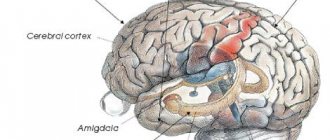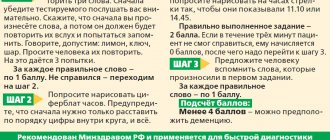Malfunctions of the central nervous system caused by various congenital or acquired diseases, organic brain damage and decreased attention due to mental disorders affect the ability to store and reproduce information, which is the basis of intelligent human activity.
As a result of the destruction of the memory mechanism, progressive mental disorders develop. Such syndromes are collectively called intellectual-mnestic disorders. They can be congenital and acquired, total and lacunar.
Types of intellectual and mnestic disorders
The classification is based on dysmnesia, which includes:
- hypermnesia
- the inability to distinguish main events from secondary ones with increased memorability; - hypomnesia
- weakening of memory in general; - retrograde amnesia
– loss of memories preceding the onset of the disease; - fixation amnesia
– shutdown of short-term memory; - progressive amnesia
- gradual erasure of memory.
The main symptom of these diseases is the degradation of the mental and mnestic abilities of the individual.
Korsakov's syndrome
In Korsakoff's syndrome, the ability to retain memories of the immediate past disappears, but long-term memory is not affected.
The patient fills gaps in memory with his own fantasies and fiction. The person turns out to be unadapted to the current situation: he cannot name the day, hour and location of his location, with whom he recently communicated and about what. Apathy, irritability, and fatigue are characteristic signs of patients with Korsakoff amnestic syndrome.
Most often, this syndrome affects elderly people, patients after a stroke, intoxication, head and brain injuries, and delirium. In the absence of organic damage to parts of the brain, restoration of short-term memory is possible.
Dementia syndrome
Dementia is a progressive dementia in which a general weakening of memory occurs, speech is distorted, motor functions are impaired, and self-control and adaptation skills are lost.
Depending on the area of damage to the brain, atrophic, vascular or mixed forms of dementia develop, of varying degrees of severity, in the form of total (complete disappearance of intelligence and personality) or lacunar (decreased intelligence with preservation of personality) dementia.
Atrophic dementias are diseases called “senile insanity” and are progressive and incurable. They end in personality disintegration (Alzheimer's disease), disability (Parkinson's disease) or personality changes (Pick's disease). The age of patients is from 50 to 65 years. Drug addiction and alcoholism can lower the age limit.
In patients with vascular dementia, against the background of fixation and progressive amnesia, lacunar dementia develops, accompanied by apathy, lethargy, unsteady gait, and urinary incontinence.
Psychoorganic syndrome
Psychoorganic syndrome means mental weakness, expressed in weakening of memory, loss of will and intelligence, and emotional instability. The disease can develop at any age, but predominates in the elderly, which is associated with atrophic changes in the brain.
There are four types of syndrome, all part of the same progressive process:
- asthenic
is unstable behavior and an inadequate reaction to ordinary events and things that deplete the patient’s neuropsychic and physical strength, without reducing mental abilities; - euphoric
- complacent, fussy stupidity, with explosions of malice and anger, turning into a depressive-tearful state; - with the explosive
variant, the signs of the first two types are supplemented by weakening of will, memory impairment and craving for alcohol; - in the case of the apathetic
variant, there is a sharp decrease in memory and intelligence, lack of will and indifference to what is happening.
Patients with organic psychosyndrome are meteodependent, and the more stable this connection is, the less the degree of brain damage. There are also acute and chronic forms of encephalopathic syndrome.
Children of any age can suffer from this intellectual and mnestic disorder, which is associated with a violation of the formation and development of the child’s brain. A long period of speech development, impulsiveness, restlessness, inattention, overestimation of one’s abilities are signs of an emerging psychosyndrome.
Congenital forms of dementia
Oligophrenia is a congenital dementia caused by hereditary, external factors or a combination of them. Today, about 300 hereditary diseases are the cause of mental retardation. Down's disease and microcephaly are a consequence of genetic pathology.
Oligophrenia has three stages:
- Moronism
is a mild degree of mental and mental disability, in which the development of an adult corresponds to 12 years of age. - Imbeciles
remain for life at the level of a 3-7 year old child. Their speech is primitive, but understandable. The behavior is not aggressive. - Idiocy
is total dementia, in which a personality is not formed, the mental abilities correspond to a 3-year-old child, constant care and control of behavior are required.
Patients with portal hypertension are characterized by neuropsychic disorders of an episodic nature: paracosismal states with polymorphic disorders, sometimes with changes in consciousness and autonomic disorders, periodic tremor of the hands, episodes of daytime sleepiness, attacks of cephalalgia, cramps. These disorders are more common in patients with surgically performed vascular anastomosis and chronic encephalopathy. Gubsky (1970) points out that intellectual-mnestic disturbances can have diagnostic value in the study of chronic HPE. The AUTHOR conducted an experimental psychological examination of patients using methods for studying memory, thinking, and the rate of motor reactions. An experimental psychological examination of patients showed that they are characterized by a decrease in memory, expressed in disruption of the learning process and a drop in the productivity of long-term retention of material. When studying thinking, changes in its operational side were revealed, which was expressed in a decrease in the level of generalizations, and in some cases in their distortion (Zeigarnik, 1962). Intellectual-mnestic disorders were found mainly in patients with the intrahepatic form of portal hypertension. Kardell et al. (1970) used a battery of psychological tests to assess the degree of cognitive decline in 34 patients with portal hypertension after surgical portacaval anastomosis. Unfortunately, the authors did not conduct a structural analysis of the identified disorders, but limited themselves to a general assessment of the success of the tests used, noting only that in chronic HPE, unlike alcoholic encephalopathy, there is no selective memory loss. This feature of the psychoorganic syndrome in GPE was noted even earlier by Vicfor (Vicfor et al., 1965), who used a set of Wechsler psychological tests. The results obtained by various authors indicate disturbances in the dynamics of mental processes, which were revealed in fluctuations in attention, exhaustion of patients, decreased ability to concentrate, instability of performance, inertia of thought processes, and disturbances in the productivity of the associative process. Along with changes in dynamics, specificity of thinking, difficulties in making complex generalizations, and the tendency of patients to detail are described. Such violations of cognitive activity are qualified in the pathopsychological literature as violations of the operational component of thinking (Zeigarnik, 1962, 1976). The degree of severity of disturbances in mental activity depends on the severity of the condition, duration and intensity of intoxication and is an objective characteristic of somatogenic encephalopathy (Tsivilno, 1970, 1977; Tsivilno, Gudkova, 1972; Kareva et al. 1979). As we see, the psychological aspects of the problem are poorly developed. At the same time, the clinic of chronic somatic diseases poses a number of questions to psychologists. One of them: how does the disease and treatment affect the patient’s personality? Most often, patients become aware of their illness and become irritable and depressed. Here the help of a psychiatrist and psychologist is needed, their choice of an adequate psychotherapeutic effect on the patient. The use of hemodialysis has made it possible to prolong the lives of those who previously died from uremia and to prepare for kidney transplantation. But the use of hemodialysis also posed a number of problems: the patient must decide to be treated with hemodialysis, and this leads to the problem of dependence on the artificial kidney machine, fear of the first hemodialysis, waiting for the installation of an arteriovenous shunt, etc. The “artificial kidney” device is far from perfect; useful substances (potassium, vitamins, etc.) are also removed from the body along with toxins. In this regard, issues of the influence of hemodialysis on the mental and somatic state of the patient must be resolved. Another question is the question of the attitude of patients to their illness, to the fact of receiving disability. It has been established that among patients, as a rule, there are two groups: patients who have completely “sunk” into the disease, and those who want to continue working and not be cut off from life. Psychologists also face the difficult problem of social and labor readaptation and rehabilitation of patients. And the solution to this issue is impossible without studying the cognitive sphere of patients.
CRF – previous page|next page – memory impairment
The impact of chronic illness on the psyche. Content.
Causes and provoking factors
Disturbances in brain function due to damage to nerve cells due to illness, injury or age-related decline are the cause of intellectual-mnestic disorders.
Weakening of memory can also be caused by a decrease in the level of concentration (attention), disturbances of consciousness. In the first case, the disorders are irreversible; in the second case, mnestic and intellectual processes can be fully restored.
The occurrence of Korsakoff syndrome is influenced by brain tumors, hypoxia, cerebral circulatory disorders, traumatic brain injuries, bilateral damage to the limbic systems, severe poisoning, including alcohol, and vitamin B deficiency (provokes gliosis, necrosis and destruction of capillaries).
Atrophy of nerve cells in the temporo-parietal region, spreading to the occipital and frontal parts, is the cause of Alzheimer's disease.
Degeneration of the frontal and frontotemporal cortices causes Pick's disease. Parkinson's disease is the result of atherosclerosis, damage to the midbrain (substantia nigra cells), heredity and repeated brain injury.
Vascular dementia is the result of impaired blood supply to the brain due to atherosclerosis, stroke, ischemia, and heart failure.
The onset of psychoorganic syndrome is provoked by various factors:
- vascular diseases of the brain;
- atherosclerotic lesions;
- brain tumors (cysts and tumors);
- encephalitis;
- traumatic brain injury;
- atrophy of brain cells;
- neurosyphilis;
- brain abscess;
- epilepsy.
An unfavorable course of pregnancy, difficult childbirth, infectious and endocrine diseases of the mother and alcoholism affect the blood supply to the child’s brain, disrupting its normal development, which can cause the birth of an oligophrenic. Rubella, toxoplasmosis, cytomegalovirus and syphilis are harbingers of embryopathy and fetopathy.
Mnestic activity of man. Peculiarities
Mnestic activity is the work of the cerebral cortex aimed at the perception, systematization and sequential reproduction of information. Only humans have the ability to remember information that is not related to the direct perception of the world through the senses. However, it is feelings that are associated with attention.
The human brain constantly perceives and analyzes the incoming stream of signals. But as conscious beings, we can selectively fix our attention on the necessary areas of knowledge and remember abstract statements that do not have visual properties.
Diagnosis and treatment concept
Oligophrenia and its degree are determined using standard psychological tests, through which the intellectual quotient (IQ) is derived:
- idiocy – IQ < 20;
- imbecility - IQ 20-49;
- debility – IQ 50-69.
Diagnosis of psychoorganic, Korsakoff, dementia and concomitant syndromes depends on the underlying disease that caused the deviations.
Standard tools for examining a patient are MRI, CT, ultrasound of the brain, as well as blood tests and observation by a psychiatrist.
Relationship between attention, intelligence and memory
The processes of mnestic activity are determined by the ability to voluntarily maintain attention on one object. Attention is a program that ensures that information that needs processing is retained in the field of consciousness. Weak control of attention is the key to the fact that it is difficult for a person to remember facts; even with good intelligence, he will not be able to achieve success in his profession.
Also with low intelligence. Even good attention, the ability to focus for a long time on one object will not help develop good memory if the intellect is poorly developed.
Memory research methods
As has been said, memory can be voluntary or involuntary; and by shelf life - short-term and long-term. To study the properties of involuntary memory, subjects were asked to do light work. And upon completion of its implementation, they were asked to tell about the main stages, about what was remembered most vividly.
Short-term memory is studied in more detail. The subjects are tested for the ability to remember objects of different modalities and for the duration of retention of this information. The amount of short-term memory is also important. Each subject has special properties. But research allows us to identify general patterns - why we remember some thoughts and facts well, and why we forget others.
The classic method for studying memory was invented by psychologist Hermann Ebbinghaus. To test memory, he suggested using syllables that were absolutely meaningless. The inability to make any associations or apply one’s intellectual abilities makes it possible to determine the pure amount of “technical memory”. That is, that reservoir in the brain where information is stored only for some urgent task.
Mechanisms of regulation and imprinting
The recording of new information goes through three stages in time: initially, based on the work of the visual, auditory and tactile analyzers, an engram is formed, that is, a special trace in the iconic memory. At the next stage, the available data is sent to the higher authorities of the brain. In certain cortical structures and parts of the limbic system, the incoming material is analyzed and sorted.
It is known that the hippocampus acts as a kind of filter, classifying all this and discarding what is unnecessary, and the task of the temporal region is to establish relationships with areas where engrams are stored from other parts of the brain. At the last stage, all this is translated into a clear circuit of long-term memory.
Classification according to the nature of mental activity
Individual characteristics of mnestic processes are characterized by what material is best absorbed: figurative, verbal, or both equally:
- Figurative memory. This is the ability to perceive and retain in memory certain visual images (ideas, pictures from life) and subsequently reproduce them; the type of memory is determined by a set of modality-specific sensations. This memory is plastic, can be long-term and appear unexpectedly. It is believed that its structure is made up of complex connections of neuronal units from different parts of the brain.
- Emotional memory. This type of memory is the result of fixations and new manifestations of emotional experiences; simply put, it is a memory for feelings. An impression that contains an emotional coloring is remembered instantly and without volitional effort, thus replenishing the structures of the human subconscious. This is a very stable mnestic type, the material of which can be reproduced completely involuntarily. Its biological basis presumably contains connections that combine subcortical neuronal links with links in different parts of the cerebral cortex.
- Semantic memory. This mnestic process correlates with the imprinting of verbal signs symbolizing what is happening in reality and internal experiences. Schematically, it represents series-connected linear links. If one of the links suffers, then this is fraught with a break in the entire chain, failure of the correct alternation of stored realities and erasing of certain fragments from memory.
Traditionally, the mnestic sphere is divided into 3 classic temporary types of memory:
- Iconic.
- Short-term (operative).
- Long-term (declarative).
Dyslexia due to memory impairment in children
Impaired memory of words and objects, difficulties with speech in early childhood may be associated with dyslexia. This is a special disorder of mnestic activity associated with a congenital anomaly in the region of the language center of the brain.
With this syndrome, the child experiences difficulty perceiving speech and dividing the flow of sounds into its component parts. Naturally, the development of memory and thinking in such children is slowed down. Studies of mnestic activity in children show that working with them, communicating, and pointing out errors of perception contribute to recovery from the syndrome.
It happens that the cause of difficulties in mastering writing is associated with visual-perceptual disorders.










